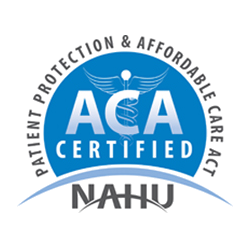Here we will provide a good overview of the Affordable Care Act with helpful links, calculators, and videos to help you understand it.
To learn about the ACA you can start with the 2 videos below or skip right to the text below them. We will cover all of the information in the videos in text as well.

Start your free ACA insurance quote
This information is general and may not apply to all people in all states.
Minimum Essential Coverage
The Affordable Care Act requires most people to have minimum essential coverage for ourselves and our dependents. Minimum essential coverage is the type of health care coverage you need to have in order to meet the individual responsibility requirement under the Affordable Care Act in order to avoid paying a penalty fee. Coverage purchased in the individual market both on and off the federal Marketplace exchange, as well as coverage under government programs such as Medicare, Medicaid, CHIP and TRICARE, and coverage under an employer-sponsored plan, meet this requirement.
Affordable Care Actr Individual Mandate Penalty
As of 2020 the Individual Mandate Penalty fee resulting from the Shared Responsibility Provision has been eliminated.
Four Metal Tiers of Coverage
In order to simplify comparing plans and establish standards of coverage, under the Affordable Care Act there will be four tiers of coverage for health insurance. The four tiers are designated by different metal descriptions: Bronze, Silver, Gold, and Platinum. Each metal tier is based on “actuarial values”, which are the average percentage of healthcare expenses paid by the plan. The “actuarial values” given below are not indicative of the plans level of benefits. In other words, a Bronze plan does not necessarily cover you at 60% across all of the plan’s benefits. It’s an average only.
Coverage of Pre-existing Health Conditions Regardless of Age
The ACA prohibits health insurance companies from limiting or excluding coverage related to pre-existing health conditions, regardless age. For persons under age 19. Health insurance companies also cannot charge more because of pre-existing conditions.
Health insurance companies are also required to renew a health plan without medical underwriting, which means they cannot increase premiums at renewal for existing customers because you incurred claims, or experienced worsening health during a policy year.
Financial Assistance (Subsidy)
Under the ACA many people will qualify for financial assistance to help pay for their healthcare and/or insurance. Generally, the lower your income is the more assistance you will receive (we have a calculator at the bottom of this page and to the right to help you determine eligibility). Assistance can come in 3 forms:
- Medicaid/CHIP: For those with incomes less than 138% of the federal poverty level (FPL). A little further down the page we have a section that explains Medicaid/CHIP.
- Advanced Premium Tax Credits: For those making up to 400% of the FPL. You can apply all or some of your premium tax credit to your monthly premium. If you don’t use it all you will get it in the form of a tax refund when you file your taxes. If your premium is more than your tax credit then you have to pay the monthly difference. In order to be eligible for this tax credit you must:
- Buy your insurance through the Marketplace exchange
- Not be eligible for other coverage from an employer or government plan
- File a joint tax return if you are married, and
- Not be claimed as a dependent by another person
- Lower cost-sharing: For those making up to 250% of the FPL. This requires you to purchase a Silver plan from the Marketplace and helps reduce your out-of-pocket maximum, deductibles, co-insurance, and co-payments.
Generally you will qualify for some form of subsidy if your income is between 100%-400% of the FPL.
Allowable Basis for Premium Variations
Under the ACA, premiums can only vary based on the following factors: age, family composition, geographic area, and tobacco use.
Age:
- Premium rates cannot vary by age for enrollees under the age of 21.
- Premium rates cannot vary by age for enrollees age 64 or older.
- Premium rates can vary by age for enrollees between the ages of 21 and 63, on each birthday, until a person turns 63.
- Older enrollees cannot be charged more than 3 times the amount that younger enrollees are charged.
Family Composition:
- Premiums may vary based on family composition.
Geographic Area:
- Geographic rating areas are established by each state. If a state does not choose its geographic rating areas, it will default to rating areas established by the Department of Health and Human Services (HHS).
Tobacco Use:
- Tobacco users cannot be charged more than 1.5 times the rate of non-users.
Health Insurance Coverage Standards
Under the ACA, all health insurance plans, whether offered on the Marketplace exchange or not, must:
- Provide, at a minimum, a package of benefits, known as Essential Health Benefits (EHB) (*see below).
- Eliminate annual dollar limits on Essential Health Benefits.
- Eliminate lifetime dollar limits on Essential Health Benefits.
- Cover certain preventive services without requiring a co-payment, co-insurance, or deductible
- Cap annual out-of-pocket spending for the consumer
Eligibility and How to Apply for an ACA Plan
You can use the Marketplace exchange to explore some of your health insurance options, even if you already have insurance. Keep in mind that shopping exclusively on the Marketplace will not show you all ACA-compliant plans! It will only show Marketplace plans. If you qualify for a significant subsidy then the Marketplace plans might make sense. Otherwise, you may be better off looking outside of the Marketplace. The best thing to do is compare all plans available to you on and off of the Marketplace exchange before deciding on a plan.
To be eligible to obtain insurance through a Marketplace exchange, you must:
- Live in the United States and be a resident of the state where you will apply for coverage and enroll in a plan
- Be a United States citizen or national (or a lawfully present non-citizen)
- Not be incarcerated, other than incarceration pending the disposition of charges

When you visit the Marketplace website, you will be able to submit an application; find information about plans; find information on assistance in paying for health insurance; and, if eligible, compare and choose among available on-exchange plans.
You will be able to complete a single application for health insurance and for your subsidy. This “no wrong door” policy means that you only need to complete one application in order to learn whether you and your family members can enroll in Children’s Health Insurance Program (CHIP) or Medicaid, or if you qualify for a subsidy.
Applications can be submitted through:
- Healthcare.gov (with or without broker/agent assistance)
- Brokers and agents like us here at RVerHealthInsurance!
- local navigators or certified application counselors
- The Federally-facilitated Marketplace toll-free call center
- The mail
Applications can also be submitted through your state Medicaid or the CHIP portals or call centers. We will discuss the Medicaid and CHIP programs more later.
After the Application Submission
After you submit an application for coverage to a Marketplace exchange, if no additional verification is required, the exchange will provide an immediate eligibility determination. and you can generally enroll immediately if done online. If you choose to mail in your application you should expect it to take much longer.
Annual Redetermination Process
Your eligibility is reassessed each year and if your income changes your subsidy will likely change as well.
Changes During the Year
The government exchange will also re-determine your eligibility if it receives and verifies new information (e.g., change of state of residence, death of a covered family member). See the Special Enrollment Periods section below for important information for RVers changing residency.
Medicaid and Children’s Health Insurance Program (CHIP)
Overview of the Medicaid Eligibility Expansion
The ACA, through Medicaid expansion, provides new opportunities for adults in some states to be covered by Medicaid. The ACA specifies that Medicaid will cover all non-elderly individuals who are ineligible for Medicare and have household income at or below 138% of the Federal Poverty Level (FPL).
However, some states have chosen not to expand Medicaid eligibility to these income levels. Regardless of whether a state chooses to expand its Medicaid eligibility all state Medicaid programs will:
- Use a new income methodology for the majority of applicants, called modified adjusted gross income (MAGI), which we will discuss on the next page
- Not consider assets in determining eligibility for individuals whose financial eligibility is based on MAGI
- Streamline income-based rules, systems, and verification procedures
IMPORTANT: South Dakota, Florida and Texas have so far chosen not to expand Medicaid. This means that if you domicile in SD, FL, or TX and your income falls below 100% of the FPL you might not be able to take advantage of neither a premium tax credit nor Medicaid! Contact Us if you are in this situation.
A Simplified Calculation of Income
The ACA requires all states to determine eligibility for Medicaid and CHIP for the majority of individuals (essentially, all non-disabled, non-elderly individuals) based on their modified adjusted gross income (MAGI). The MAGI calculation equals adjusted gross income as defined by the Internal Revenue Service (IRS), plus any foreign income, tax-exempt interest, and non-taxable Social Security benefits–see this page’s sidebar for a more thorough description of your MAGI. Assets will not be considered in determining eligibility. This is the same income methodology that will be used for determining eligibility for the federal subsidy, with a notable exception:
IMPORTANT: Medicaid and CHIP eligibility is primarily based on current monthly income, while eligibility for a federal subsidy is based on projected annual household income.
Enrollment Periods
After your eligibility has been determined, you may enroll in a plan during various time frames throughout the year. The two time frames are the annual Open Enrollment period, and Special Enrollment Periods (SEP).
- Open Enrollment periods for the coming year are typically in late fall. You can usually find the date later in the year here on RVer Insurance and HealthCare.gov.
- Special Enrollment Periods occur throughout the year, based on special circumstances.
The Marketplace exchanges will send an annual open enrollment notice to each enrollee, usually between September 1 and September 30, to ensure enrollees are aware of the upcoming annual open enrollment period.
Special Enrollment Periods
Under certain circumstances, individuals may change plans outside of the annual open enrollment period. These SEPs are based on certain triggering events or exceptional circumstances.
Events that permit a SEP include, but are not limited to:
- Gaining or becoming a dependent
- Marriage
- Gaining status as a citizen, national, or lawfully present individual
- Loss of minimum essential coverage (e.g., loss of Medicaid eligibility, termination of a plan), except if enrollment is terminated based on failure to pay premiums
- Loss of affordable employer-sponsored coverage
- Determination that an individual is newly eligible or ineligible for premium tax credits or a change in eligibility for cost-sharing reductions
- *Permanent move to an area where different plans are available
- Other exceptional circumstances identified by the Marketplace
*Notice this SEP! If you decide to change your domicile in the middle of the year then you qualify for an SEP and can change your plan!
In most cases, SEPs will extend for 60 days from the date of the triggering event.
Can you Cancel?
You can cancel your coverage at any time of the year, including as the result of obtaining other minimum essential coverage (e.g., Medicaid, employer-sponsored insurance coverage), after giving appropriate notice to your insurance company. Just keep in mind that if you do not replace it with another qualified plan you will be assessed the “penalty”.
Insurance companies can terminate your coverage if you:
- Are no longer eligible for coverage in a plan through the Marketplace
- Fail to pay premiums, consistent with the three-month minimum grace period requirement
- Have obtained coverage based on fraud or an intentional misrepresentation of material fact
When you select a different plan on the exchange during an applicable enrollment period, coverage under the previous plan will end automatically on the date that coverage under the new plan takes effect.
The enrollment periods apply to both on and off-exchange plans. However, off-exchange plans can allow other enrollment periods beyond what the government has established for on-exchange plans. At a minimum, they must allow you to enroll during the same dates as on-exchange plans.
State-by-State
Each state has the option to either set up it’s own marketplace exchange or default to the federal exchange. If you contact us we will be able to tell you more about your specific state. However, if you just want detailed information and updates about a particular state’s exchange participation, we suggest clicking here (external link) for the latest updates from the Henry J. Kaiser Family Foundation.
Medicare and the Affordable Care Act
The ACA really does not have anything in it that directly affects anyone’s eligibility, benefits, or access to care under original Medicare. That’s the good news. However, some of the potentially good parts of the legislation also do not apply to Medicare. For example, under the ACA the following new laws that apply to health insurance do not apply to Medicare Supplement insurance:
- Pre-existing conditions: Even though Medicare does not turn people away for pre-existing conditions, Medicare Supplement companies still can unless you enroll during certain guaranteed issue periods such as when you are turning 65 or lose other coverage.
- Medical Loss Ratio (MLR): The law that states an insurance company must spend a certain percentage (usually 85%) of premium dollars on medical claims does not apply to Medicare Supplement plans.
Why don’t these new laws extend to the Medicare products? Well, the Centers for Medicare and Medicaid Services (CMS) already heavily regulates these markets. Both Medicare Supplements, Medicare Advantage, and Medicare Part D Rx plans have their own guarantee issue rules in place, though they are different than those under ACA. Please see our Medicare page and the other Medicare product pages on this site for more information; or contact us with your questions.

